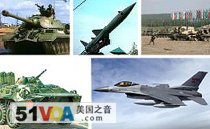Washington
27 April 2009
New data shows that arms transfers to the Middle East have increased by 38 percent during the past five years, compared to the previous five. The data show the United States, Russia and Germany remain the world's largest arms exporters.
 |
| Russian weaponry |
Arms transfers had been at their lowest level since the 1960's during the previous reporting period between 1999-2003.
The list of top arms exporters has remained constant for many years, as Paul Holtom, the Head of SIPRI's Arms Transfer Program explains.
"The top five suppliers, that is the U.S.A, Russia, Germany, France and the U.K. (United Kingdom), they are mainstays really in those positions. They switch around sometimes, but you know, the U.S.A. and Russia are really in a league of their own," said Holtom.
Russian arms exports were 14 percent higher from 2004-2008 than the previous five years, largely due to increased deliveries to Asia, Africa and Latin America. Holtom says increasing oil prices during that period, which have since leveled off, appear to be one of the factors that contributed to increased purchases of conventional weapons.
"In recent years we have seen oil-rich states in the Middle East, and also Algeria and Venezuela really rise in the rankings, as they have had the funds to be able to pay for the modernization, upgrading and re-equipping of their armed forces," said Holtom.
Holtom said it is hard to predict what impact falling oil prices and the global economic crisis will have on the global arms trade in the years ahead. But he said there are early signs of some countries cutting back on their purchases.
"For example, Malaysia has cut orders for helicopters. And we are seeing Brazil, which we thought was going to emerge as a big recipient, re-assessing its position on whether it is going to go ahead with some of these big deals."
But Holtom said if you look back to the Great Depression in the 1930's, arms sales actually increased.
The SIPRI reports show there were increasing volumes of arms transfers from 2004-2008 in states involved in armed conflict including Afghanistan, Georgia, Israel, Pakistan and Sri Lanka.